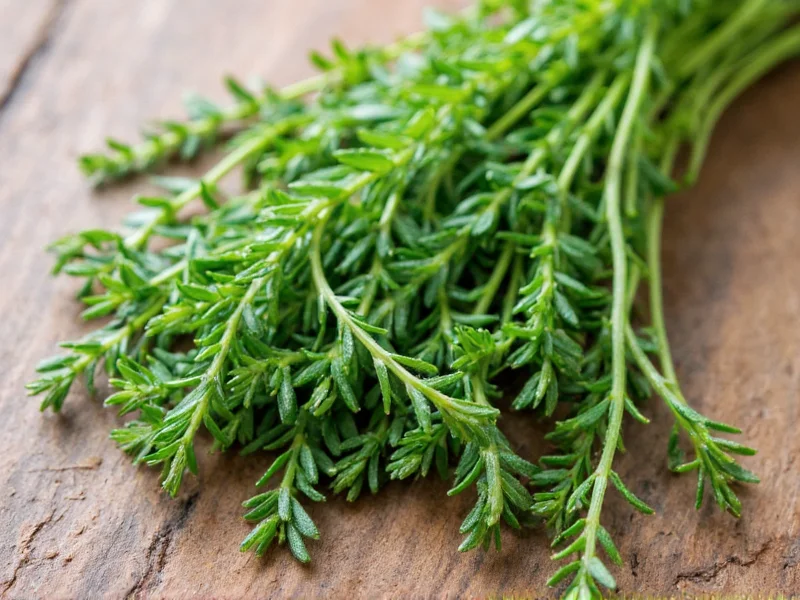When selecting good thyme for your kitchen, understanding quality indicators is essential. Fresh thyme should have bright green leaves without yellowing or browning. The stems should feel firm and slightly woody, not limp or slimy. Properly harvested thyme releases a distinctive herbal aroma when gently rubbed between your fingers—a clear sign of freshness and potency.
What Makes Thyme "Good" Quality
The difference between average and exceptional thyme comes down to several key factors. First, examine the color—vibrant green indicates recent harvest and optimal flavor compounds. Avoid thyme with black spots, yellow leaves, or excessive flowering, as these signal aging and diminished flavor.
Good thyme maintains its structure when handled. The leaves should stay firmly attached to the stems rather than falling off with light pressure. This characteristic matters significantly for both presentation and flavor retention during cooking. When evaluating how to select fresh thyme, remember that the most aromatic sprigs typically deliver the best culinary results.
Proper Storage Techniques for Maximum Freshness
Knowing the best way to store thyme extends its shelf life and preserves flavor. For immediate use within 2-3 days, wrap fresh thyme sprigs in a slightly damp paper towel and place them in a resealable container in your refrigerator's crisper drawer. For longer storage, trim the stems and place them upright in a glass with about an inch of water, covering loosely with a plastic bag.
| Storage Method | Duration | Quality Preservation |
|---|---|---|
| Refrigerator in water | Up to 2 weeks | Excellent |
| Damp paper towel method | 3-5 days | Good |
| Freezing in oil | 6 months | Fair (best for cooked dishes) |
| Drying | 6-12 months | Moderate (flavor concentrates) |
Culinary Applications of Fresh Thyme
Understanding thyme culinary uses enhances your cooking significantly. Fresh thyme works exceptionally well in slow-cooked dishes where its flavor can fully develop, such as stews, braises, and roasts. The herb's essential oils withstand long cooking times better than many delicate herbs.
For immediate flavor impact in salads, sauces, or finishing dishes, remove leaves from stems and chop finely. Good thyme's flavor profile combines earthy, slightly floral, and subtle minty notes that complement poultry, lamb, vegetables, and tomato-based dishes. When substituting fresh for dried thyme, use a 3:1 ratio (three parts fresh to one part dried) due to concentration differences.
Growing Your Own Quality Thyme
For those interested in growing thyme at home, this perennial herb thrives in well-draining soil with full sun exposure. Start with a healthy plant rather than seeds for faster results. Harvest thyme in the morning after the dew has dried but before the sun becomes intense, when essential oil concentration peaks.
Regular harvesting actually encourages bushier growth. When cutting sprigs, take no more than one-third of the plant at a time to maintain plant health. Good thyme from your garden will have superior flavor compared to store-bought varieties, especially when harvested at the optimal time just before flowering.
Nutritional Benefits and Flavor Chemistry
Thyme's health benefits stem from its rich composition of thymol, carvacrol, and other volatile oils. These compounds give thyme its distinctive aroma and contribute to its antimicrobial properties. A single tablespoon of fresh thyme provides notable amounts of vitamin K, iron, and manganese.
The flavor intensity of good thyme directly correlates with its essential oil content. Factors like soil composition, sunlight exposure, and harvest timing significantly affect these compounds. Mediterranean-grown thyme often exhibits more intense flavor due to the region's ideal growing conditions of abundant sun and well-drained soils.
Common Mistakes When Using Thyme
Many home cooks make critical errors that diminish thyme's potential. Adding whole sprigs to finished dishes creates unpleasant woody textures. Instead, strip leaves from stems before adding to salads or cold preparations. When using in long-cooked dishes, add whole sprigs early and remove before serving.
Another frequent mistake involves improper washing. Excessive moisture accelerates spoilage, so wash thyme only when ready to use and dry thoroughly. Never store thyme in airtight containers without ventilation, as trapped moisture promotes mold growth. Understanding fresh thyme vs dried thyme applications prevents flavor imbalances in your recipes.
Seasonal Availability and Substitutes
Fresh thyme reaches peak quality during summer months but remains available year-round in most markets. During off-season, dried thyme becomes a valuable alternative, though it lacks the bright top notes of fresh sprigs. When fresh thyme isn't available, oregano or marjoram make the closest substitutes due to similar flavor profiles, though each brings distinct characteristics.
For Mediterranean dishes, rosemary can work in a pinch but use sparingly as its flavor is more assertive. The key to successful substitution lies in understanding thyme flavor profile components and matching them as closely as possible with available herbs.











 浙公网安备
33010002000092号
浙公网安备
33010002000092号 浙B2-20120091-4
浙B2-20120091-4